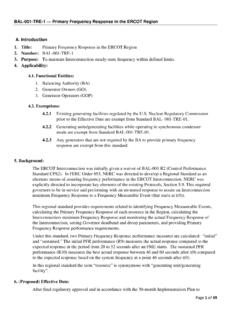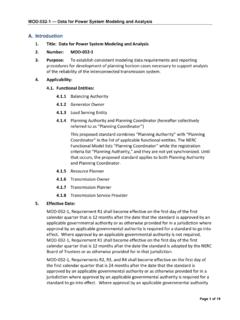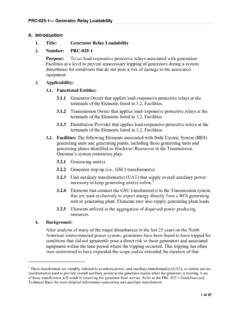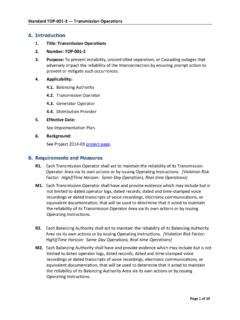Transcription of TLP: White Analysis of the Cyber Attack on the Ukrainian ...
1 TLP: White Analysis of the Cyber Attack on the Ukrainian Power Grid Defense Use Case March 18, 2016. NERC | Report Title | Report Date I. Table of Contents Preface: Analysis of the Cyber Attack on the Ukrainian Power Grid .. iii Summary of Incidents .. 1. Summary of Information and Reporting .. 2. Attacker Tactics Techniques and Procedures Description .. 4. ICS Cyber Kill Chain Mapping .. 7. ICS Cyber Kill Chain Mapping Stage 8. ICS Cyber Kill Chain Mapping Stage 10. Defense Lessons Learned Passive and Active Defenses .. 14. 21. Implications and Conclusion .. 23. Appendix Information Evaluation .. 25. E ISAC | Analysis of the Cyber Attack on the Ukrainian Power Grid | March 18, 2016. ii Preface Analysis of the Cyber Attack on the Ukrainian Power Grid This is an Analysis by a joint team to provide a lessons learned community resource from the Cyber Attack on the Ukrainian power grid. The document is being released as Traffic Light Protocol: White (TLP: White ) and may be distributed without restriction, subject to copyright controls.
2 This document, the Defense Use Case (DUC), summarizes important learning points and presents several mitigation ideas based on publicly available information on ICS incidents in Ukraine. The E ISAC and SANS are providing a summary of the available information compiled from multiple publicly available sources as well as Analysis performed by the SANS team in relation to this This document provides specific mitigation concepts for power system Supervisory Control and Data Acquisition (SCADA) defense, as well as a general learning opportunity for ICS defenders. Authors, working with the E ISAC: Robert M. Lee, SANS. Michael J. Assante, SANS. Tim Conway, SANS. 1 The SANS investigation into this incident should not be confused with the interagency team investigation or any other organization or company's efforts to include the E ISAC's past reporting. SANS ICS team has been analyzing the data on their own since December 25, 2015, and has provided its Analysis to the wider community.
3 This document is provided to E ISAC and the North American electricity sector to benefit its members and the larger critical infrastructure community. E ISAC | Analysis of the Cyber Attack on the Ukrainian Power Grid | March 18, 2016. iii Summary of Incidents On December 23, 2015, the Ukrainian Kyivoblenergo, a regional electricity distribution company, reported service outages to customers. The outages were due to a third party's illegal entry into the company's computer and SCADA systems: Starting at approximately 3:35 local time, seven 110 kV and 23 35 kV substations were disconnected for three hours. Later statements indicated that the Cyber Attack impacted additional portions of the distribution grid and forced operators to switch to manual , 3 The event was elaborated on by the Ukrainian news media, who conducted interviews and determined that a foreign attacker remotely controlled the SCADA distribution management The outages were originally thought to have affected approximately 80,000 customers, based on the Kyivoblenergo's update to customers.
4 However, later it was revealed that three different distribution oblenergos (a term used to describe an energy company) were attacked, resulting in several outages that caused approximately 225,000 customers to lose power across various , 6. Shortly after the Attack , Ukrainian government officials claimed the outages were caused by a Cyber Attack , and that Russian security services were responsible for the Following these claims, investigators in Ukraine, as well as private companies and the government, performed Analysis and offered assistance to determine the root cause of the Both the E ISAC and SANS ICS team was involved in various efforts and analyses in relation to this case since December 25, 2015, working with trusted members and organizations in the community. This joint report consolidates the open source information, clarifying important details surrounding the Attack , offering lessons learned, and recommending approaches to help the ICS community repel similar attacks.
5 This report does not focus on attribution of the Attack . 2 3 godyn 4 5 6 7 8 E ISAC | Analysis of the Cyber Attack on the Ukrainian Power Grid | March 18, 2016. 1. Summary of Information and Reporting Background On December 24, 2015, TSN (a Ukrainian news outlet) released the report Due to a Hacker Attack Half of the Ivano Frankivsk Region is De Energized. 10 Numerous reporting agencies and independent bloggers from the Washington Post, SANS Institute, New York Times, ARS Technica, BBC, Wired, CNN, Fox News, and the E ISAC. Report have followed up on the initial TSN These subsequent reports have collectively provided details of a Cyber Attack that targeted the Ukrainian electric system. The Department of Homeland Security (DHS). issued a formal report on February 25, 2016, titled IR ALERT H 16 056 Based on the DHS report, three Ukrainian oblenergos experienced coordinated Cyber attacks that were executed within 30 minutes of each other.
6 The Attack impacted 225,000 customers and required the oblenergos to move to manual operations in response to the Attack . The oblenergos were reportedly able to restore service quickly after an outage window lasting several The DHS report states that, while electrical service was restored, the impacted oblenergos continue to operate their distribution systems in an operationally constrained mode. Within the Ukrainian electrical system, these attacks were directed at the regional distribution level, as shown in Figure 1. Figure 1: Electric System Overview 9 10 E ISAC: Mitigating Adversarial Manipulation of Industrial Control Systems as Evidenced by Recent International Events, February 9, 2016. (TLP=RED). 11 12 ukraine/2016/01/05 E ISAC | Analysis of the Cyber Attack on the Ukrainian Power Grid | March 18, 2016. 2. Summary of Information and Reporting See the Appendix for an evaluation of the credibility and amount of technical information that is publicly available.
7 Keeping Perspective The Cyber attacks in Ukraine are the first publicly acknowledged incidents to result in power outages. As future attacks may occur, it is important to scope the impacts of the incident. Power outages should be measured in scale (number of customers and amount of electricity infrastructure involved) and in duration to full restoration. The Ukrainian incidents affected up to 225,000 customers in three different distribution level service territories and lasted for several hours. These incidents should be rated on a macro scale as low in terms of power system impacts as the outage affected a very small number of overall power consumers in Ukraine and the duration was limited. In contrast, it is likely that the impacted companies rate these incidents as high or critical to the reliability of their systems and business operations. E ISAC | Analysis of the Cyber Attack on the Ukrainian Power Grid | March 18, 2016.
8 3. Attacker Tactics Techniques and Procedures Description Direct attribution is unnecessary to learn from this Attack and to consider mitigation strategies; it is only necessary to use the mental model of how the Cyber actor works to understand the capabilities and general profile against which one is defending. The motive and sophistication of this power grid Attack is consistent with a highly structured and resourced actor. This actor was co adaptive and demonstrated varying tactics and techniques to match the defenses and environment of the three impacted targets. The mitigation section of this document provides mitigation concepts related to the Attack and how to develop a more lasting mitigation strategy by anticipating future attacks. Capability The attackers demonstrated a variety of capabilities, including spear phishing emails, variants of the BlackEnergy 3 malware, and the manipulation of Microsoft Office documents that contained the malware to gain a foothold into the Information Technology (IT) networks of the electricity They demonstrated the capability to gain a foothold and harvest credentials and information to gain access to the ICS network.
9 Additionally, the attackers showed expertise, not only in network connected infrastructure; such as Uninterruptable Power Supplies (UPSs), but also in operating the ICSs through supervisory control system; such as the Human Machine Interface (HMI), as shown in Figure 2. Figure 2: Control & Operate: SCADA Hijacking Techniques Finally, the adversaries demonstrated the capability and willingness to target field devices at substations, write custom malicious firmware, and render the devices, such as serial to ethernet convertors, inoperable and 13 Fora discussion around the history of the BlackEnergy 3 malware and Sandworm team see the SANS ICS webcast with iSight here: E ISAC | Analysis of the Cyber Attack on the Ukrainian Power Grid | March 18, 2016. 4. Attacker Tactics Techniques and Procedures Description In one case, the attackers also used telephone systems to generate thousands of calls to the energy company's call center to deny access to customers reporting outages.
10 However, the strongest capability of the attackers was not in their choice of tools or in their expertise, but in their capability to perform long term reconnaissance operations required to learn the environment and execute a highly synchronized, multistage, multisite Attack . The following is a consolidated list of the technical components used by the attackers, graphically depicted in Figure 3: Spear phishing to gain access to the business networks of the oblenergos Identification of BlackEnergy 3 at each of the impacted oblenergos Theft of credentials from the business networks The use of virtual private networks (VPNs) to enter the ICS network The use of existing remote access tools within the environment or issuing commands directly from a remote station similar to an operator HMI. Serial to ethernet communications devices impacted at a firmware level16. The use of a modified KillDisk to erase the master boot record of impacted organization systems as well as the targeted deletion of some logs17.
















